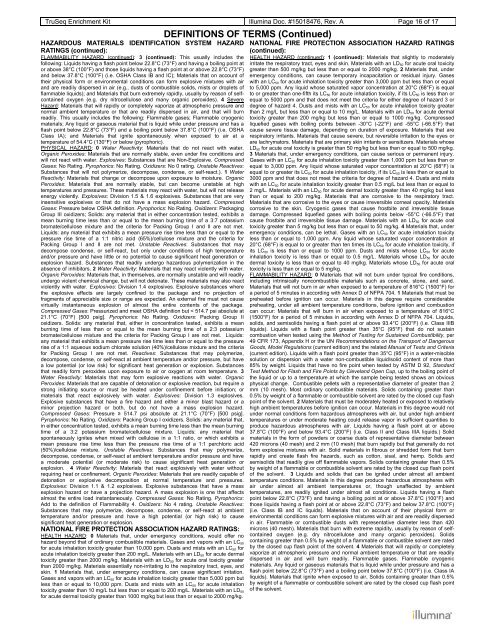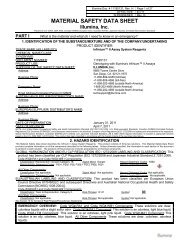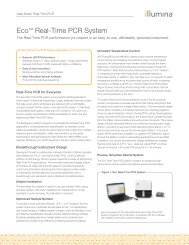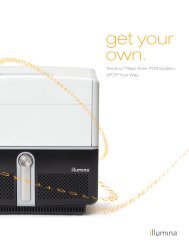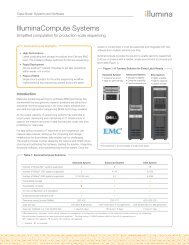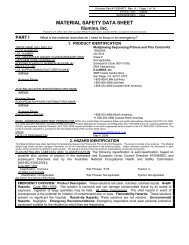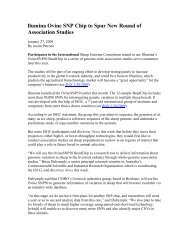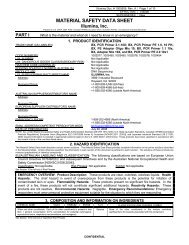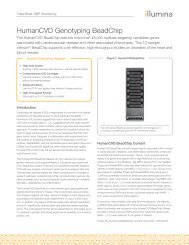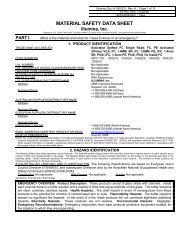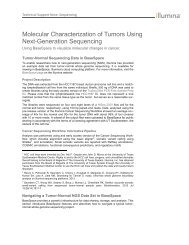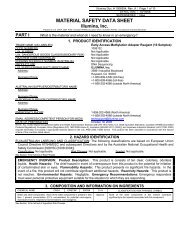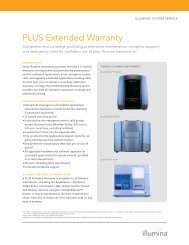MATERIAL SAFETY DATA SHEET - Illumina
MATERIAL SAFETY DATA SHEET - Illumina
MATERIAL SAFETY DATA SHEET - Illumina
You also want an ePaper? Increase the reach of your titles
YUMPU automatically turns print PDFs into web optimized ePapers that Google loves.
TruSeq Enrichment Kit <strong>Illumina</strong> Doc. #15018476, Rev. A Page 16 of 17<br />
HAZARDOUS <strong>MATERIAL</strong>S IDENTIFICATION SYSTEM HAZARD<br />
RATINGS (continued):<br />
FLAMMABILITY HAZARD (continued): 3 (continued): This usually includes the<br />
following: Liquids having a flash point below 22.8°C (73°F) and having a boiling point at<br />
or above 38°C (100°F) and those liquids having a flash point at or above 22.8°C (73°F)<br />
and below 37.8°C (100°F) (i.e. OSHA Class IB and IC); Materials that on account of<br />
their physical form or environmental conditions can form explosive mixtures with air<br />
and are readily dispersed in air (e.g., dusts of combustible solids, mists or droplets of<br />
flammable liquids); and Materials that burn extremely rapidly, usually by reason of selfcontained<br />
oxygen (e.g. dry nitrocellulose and many organic peroxides). 4 Severe<br />
Hazard: Materials that will rapidly or completely vaporize at atmospheric pressure and<br />
normal ambient temperature or that are readily dispersed in air, and that will burn<br />
readily. This usually includes the following: Flammable gases; Flammable cryogenic<br />
materials; Any liquid or gaseous material that is liquid while under pressure and has a<br />
flash point below 22.8°C (73°F) and a boiling point below 37.8°C (100°F) (i.e. OSHA<br />
Class IA); and Materials that ignite spontaneously when exposed to air at a<br />
temperature of 54.4°C (130°F) or below (pyrophoric).<br />
PHYSICAL HAZARD: 0 Water Reactivity: Materials that do not react with water.<br />
Organic Peroxides: Materials that are normally stable, even under fire conditions and<br />
will not react with water. Explosives: Substances that are Non-Explosive. Compressed<br />
Gases: No Rating. Pyrophorics: No Rating. Oxidizers: No 0 rating. Unstable Reactives:<br />
Substances that will not polymerize, decompose, condense, or self-react.). 1 Water<br />
Reactivity: Materials that change or decompose upon exposure to moisture. Organic<br />
Peroxides: Materials that are normally stable, but can become unstable at high<br />
temperatures and pressures. These materials may react with water, but will not release<br />
energy violently. Explosives: Division 1.5 & 1.6 explosives. Substances that are very<br />
insensitive explosives or that do not have a mass explosion hazard. Compressed<br />
Gases: Pressure below OSHA definition. Pyrophorics: No Rating. Oxidizers: Packaging<br />
Group III oxidizers; Solids: any material that in either concentration tested, exhibits a<br />
mean burning time less than or equal to the mean burning time of a 3:7 potassium<br />
bromate/cellulose mixture and the criteria for Packing Group I and II are not met.<br />
Liquids: any material that exhibits a mean pressure rise time less than or equal to the<br />
pressure rise time of a 1:1 nitric acid (65%)/cellulose mixture and the criteria for<br />
Packing Group I and II are not met. Unstable Reactives: Substances that may<br />
decompose condense, or self-react, but only under conditions of high temperature<br />
and/or pressure and have little or no potential to cause significant heat generation or<br />
explosion hazard. Substances that readily undergo hazardous polymerization in the<br />
absence of inhibitors. 2 Water Reactivity: Materials that may react violently with water.<br />
Organic Peroxides: Materials that, in themselves, are normally unstable and will readily<br />
undergo violent chemical change, but will not detonate. These materials may also react<br />
violently with water. Explosives: Division 1.4 explosives. Explosive substances where<br />
the explosive effects are largely confined to the package and no projection of<br />
fragments of appreciable size or range are expected. An external fire must not cause<br />
virtually instantaneous explosion of almost the entire contents of the package.<br />
Compressed Gases: Pressurized and meet OSHA definition but < 514.7 psi absolute at<br />
21.1°C (70°F) [500 psig]. Pyrophorics: No Rating. Oxidizers: Packing Group II<br />
oxidizers. Solids: any material that, either in concentration tested, exhibits a mean<br />
burning time of less than or equal to the mean burning time of a 2:3 potassium<br />
bromate/cellulose mixture and the criteria for Packing Group I are not met. Liquids:<br />
any material that exhibits a mean pressure rise time less than or equal to the pressure<br />
rise of a 1:1 aqueous sodium chlorate solution (40%)/cellulose mixture and the criteria<br />
for Packing Group I are not met. Reactives: Substances that may polymerize,<br />
decompose, condense, or self-react at ambient temperature and/or pressure, but have<br />
a low potential (or low risk) for significant heat generation or explosion. Substances<br />
that readily form peroxides upon exposure to air or oxygen at room temperature. 3<br />
Water Reactivity: Materials that may form explosive reactions with water. Organic<br />
Peroxides: Materials that are capable of detonation or explosive reaction, but require a<br />
strong initiating source or must be heated under confinement before initiation; or<br />
materials that react explosively with water. Explosives: Division 1.3 explosives.<br />
Explosive substances that have a fire hazard and either a minor blast hazard or a<br />
minor projection hazard or both, but do not have a mass explosion hazard.<br />
Compressed Gases: Pressure ≥ 514.7 psi absolute at 21.1°C (70°F) [500 psig].<br />
Pyrophorics: No Rating. Oxidizers: Packing Group I oxidizers. Solids: any material that,<br />
in either concentration tested, exhibits a mean burning time less than the mean burning<br />
time of a 3:2 potassium bromate/cellulose mixture. Liquids: any material that<br />
spontaneously ignites when mixed with cellulose in a 1:1 ratio, or which exhibits a<br />
mean pressure rise time less than the pressure rise time of a 1:1 perchloric acid<br />
(50%)/cellulose mixture. Unstable Reactives: Substances that may polymerize,<br />
decompose, condense, or self-react at ambient temperature and/or pressure and have<br />
a moderate potential (or moderate risk) to cause significant heat generation or<br />
explosion. 4 Water Reactivity: Materials that react explosively with water without<br />
requiring heat or confinement. Organic Peroxides: Materials that are readily capable of<br />
detonation or explosive decomposition at normal temperature and pressures.<br />
Explosives: Division 1.1 & 1.2 explosives. Explosive substances that have a mass<br />
explosion hazard or have a projection hazard. A mass explosion is one that affects<br />
almost the entire load instantaneously. Compressed Gases: No Rating. Pyrophorics:<br />
Add to the definition of Flammability 4. Oxidizers: No 4 rating. Unstable Reactives:<br />
Substances that may polymerize, decompose, condense, or self-react at ambient<br />
temperature and/or pressure and have a high potential (or high risk) to cause<br />
significant heat generation or explosion.<br />
NATIONAL FIRE PROTECTION ASSOCIATION HAZARD RATINGS:<br />
HEALTH HAZARD: 0 Materials that, under emergency conditions, would offer no<br />
hazard beyond that of ordinary combustible materials. Gases and vapors with an LC50<br />
for acute inhalation toxicity greater than 10,000 ppm. Dusts and mists with an LC50 for<br />
acute inhalation toxicity greater than 200 mg/L. Materials with an LD50 for acute dermal<br />
toxicity greater than 2000 mg/kg. Materials with an LD50 for acute oral toxicity greater<br />
than 2000 mg/kg. Materials essentially non-irritating to the respiratory tract, eyes, and<br />
skin. 1 Materials that, under emergency conditions, can cause significant irritation.<br />
Gases and vapors with an LC50 for acute inhalation toxicity greater than 5,000 ppm but<br />
less than or equal to 10,000 ppm. Dusts and mists with an LC50 for acute inhalation<br />
toxicity greater than 10 mg/L but less than or equal to 200 mg/L. Materials with an LD50<br />
for acute dermal toxicity greater than 1000 mg/kg but less than or equal to 2000 mg/kg.<br />
DEFINITIONS OF TERMS (Continued)<br />
NATIONAL FIRE PROTECTION ASSOCIATION HAZARD RATINGS<br />
(continued):<br />
HEALTH HAZARD (continued): 1 (continued): Materials that slightly to moderately<br />
irritate the respiratory tract, eyes and skin. Materials with an LD50 for acute oral toxicity<br />
greater than 500 mg/kg but less than or equal to 2000 mg/kg. 2 Materials that, under<br />
emergency conditions, can cause temporary incapacitation or residual injury. Gases<br />
with an LC50 for acute inhalation toxicity greater than 3,000 ppm but less than or equal<br />
to 5,000 ppm. Any liquid whose saturated vapor concentration at 20°C (68°F) is equal<br />
to or greater than one-fifth its LC50 for acute inhalation toxicity, if its LC50 is less than or<br />
equal to 5000 ppm and that does not meet the criteria for either degree of hazard 3 or<br />
degree of hazard 4. Dusts and mists with an LC50 for acute inhalation toxicity greater<br />
than 2 mg/L but less than or equal to 10 mg/L. Materials with an LD50 for acute dermal<br />
toxicity greater than 200 mg/kg but less than or equal to 1000 mg/kg. Compressed<br />
liquefied gases with boiling points between -30°C (-22°F) and -55°C (-66.5°F) that<br />
cause severe tissue damage, depending on duration of exposure. Materials that are<br />
respiratory irritants. Materials that cause severe, but reversible irritation to the eyes or<br />
are lachrymators. Materials that are primary skin irritants or sensitizers. Materials whose<br />
LD50 for acute oral toxicity is greater than 50 mg/kg but less than or equal to 500 mg/kg.<br />
3 Materials that, under emergency conditions, can cause serious or permanent injury.<br />
Gases with an LC50 for acute inhalation toxicity greater than 1,000 ppm but less than or<br />
equal to 3,000 ppm. Any liquid whose saturated vapor concentration at 20°C (68°F) is<br />
equal to or greater its LC50 for acute inhalation toxicity, if its LC50 is less than or equal to<br />
3000 ppm and that does not meet the criteria for degree of hazard 4. Dusts and mists<br />
with an LC50 for acute inhalation toxicity greater than 0.5 mg/L but less than or equal to<br />
2 mg/L. Materials with an LD50 for acute dermal toxicity greater than 40 mg/kg but less<br />
than or equal to 200 mg/kg. Materials that are corrosive to the respiratory tract.<br />
Materials that are corrosive to the eyes or cause irreversible corneal opacity. Materials<br />
corrosive to the skin. Cryogenic gases that cause frostbite and irreversible tissue<br />
damage. Compressed liquefied gases with boiling points below -55°C (-66.5°F) that<br />
cause frostbite and irreversible tissue damage. Materials with an LD50 for acute oral<br />
toxicity greater than 5 mg/kg but less than or equal to 50 mg/kg. 4 Materials that, under<br />
emergency conditions, can be lethal. Gases with an LC50 for acute inhalation toxicity<br />
less than or equal to 1,000 ppm. Any liquid whose saturated vapor concentration at<br />
20°C (68°F) is equal to or greater than ten times its LC50 for acute inhalation toxicity, if<br />
its LC50 is less than or equal to 1000 ppm. Dusts and mists whose LC50 for acute<br />
inhalation toxicity is less than or equal to 0.5 mg/L. Materials whose LD50 for acute<br />
dermal toxicity is less than or equal to 40 mg/kg. Materials whose LD50 for acute oral<br />
toxicity is less than or equal to 5 mg/kg.<br />
FLAMMABILITY HAZARD: 0 Materials that will not burn under typical fire conditions,<br />
including intrinsically noncombustible materials such as concrete, stone, and sand.<br />
Materials that will not burn in air when exposed to a temperature of 816°C (1500°F) for<br />
a period of 5 minutes in according with Annex D of NFPA 704. 1 Materials that must be<br />
preheated before ignition can occur. Materials in this degree require considerable<br />
preheating, under all ambient temperature conditions, before ignition and combustion<br />
can occur: Materials that will burn in air when exposed to a temperature of 816°C<br />
(1500°F) for a period of 5 minutes in according with Annex D of NFPA 704. Liquids,<br />
solids, and semisolids having a flash point at or above 93.4°C (200°F) (i.e. Class IIIB<br />
liquids). Liquids with a flash point greater than 35°C (95°F) that do not sustain<br />
combustion when tested using the Method of Testing for Sustained Combustibility, per<br />
49 CFR 173, Appendix H or the UN Recommendations on the Transport of Dangerous<br />
Goods, Model Regulations (current edition) and the related Manual of Tests and Criteria<br />
(current edition). Liquids with a flash point greater than 35°C (95°F) in a water-miscible<br />
solution or dispersion with a water non-combustible liquid/solid content of more than<br />
85% by weight. Liquids that have no fire point when tested by ASTM D 92, Standard<br />
Test Method for Flash and Fire Points by Cleveland Open Cup, up to the boiling point of<br />
the liquid or up to a temperature at which the sample being tested shows an obvious<br />
physical change. Combustible pellets with a representative diameter of greater than 2<br />
mm (10 mesh). Most ordinary combustible materials. Solids containing greater than<br />
0.5% by weight of a flammable or combustible solvent are rated by the closed cup flash<br />
point of the solvent. 2 Materials that must be moderately heated or exposed to relatively<br />
high ambient temperatures before ignition can occur. Materials in this degree would not<br />
under normal conditions form hazardous atmospheres with air, but under high ambient<br />
temperatures or under moderate heating could release vapor in sufficient quantities to<br />
produce hazardous atmospheres with air. Liquids having a flash point at or above<br />
37.8°C (100°F) and below 93.4°C (200°F) (i.e. Class II and Class IIIA liquids.) Solid<br />
materials in the form of powders or coarse dusts of representative diameter between<br />
420 microns (40 mesh) and 2 mm (10 mesh) that burn rapidly but that generally do not<br />
form explosive mixtures with air. Solid materials in fibrous or shredded form that burn<br />
rapidly and create flash fire hazards, such as cotton, sisal, and hemp. Solids and<br />
semisolids that readily give off flammable vapors. Solids containing greater than 0.5%<br />
by weight of a flammable or combustible solvent are rated by the closed cup flash point<br />
of the solvent. 3 Liquids and solids that can be ignited under almost all ambient<br />
temperature conditions. Materials in this degree produce hazardous atmospheres with<br />
air under almost all ambient temperatures or, though unaffected by ambient<br />
temperatures, are readily ignited under almost all conditions. Liquids having a flash<br />
point below 22.8°C (73°F) and having a boiling point at or above 37.8°C (100°F) and<br />
those liquids having a flash point at or above 22.8°C (73°F) and below 37.8°C (100°F)<br />
(i.e. Class IB and IC liquids). Materials that on account of their physical form or<br />
environmental conditions can form explosive mixtures with air and are readily dispersed<br />
in air. Flammable or combustible dusts with representative diameter less than 420<br />
microns (40 mesh). Materials that burn with extreme rapidity, usually by reason of selfcontained<br />
oxygen (e.g. dry nitrocellulose and many organic peroxides). Solids<br />
containing greater than 0.5% by weight of a flammable or combustible solvent are rated<br />
by the closed cup flash point of the solvent. 4 Materials that will rapidly or completely<br />
vaporize at atmospheric pressure and normal ambient temperature or that are readily<br />
dispersed in air and will burn readily. Flammable gases. Flammable cryogenic<br />
materials. Any liquid or gaseous materials that is liquid while under pressure and has a<br />
flash point below 22.8°C (73°F) and a boiling point below 37.8°C (100°F) (i.e. Class IA<br />
liquids). Materials that ignite when exposed to air, Solids containing greater than 0.5%<br />
by weight of a flammable or combustible solvent are rated by the closed cup flash point<br />
of the solvent.


